Question Number 23707 by Tinkutara last updated on 04/Nov/17
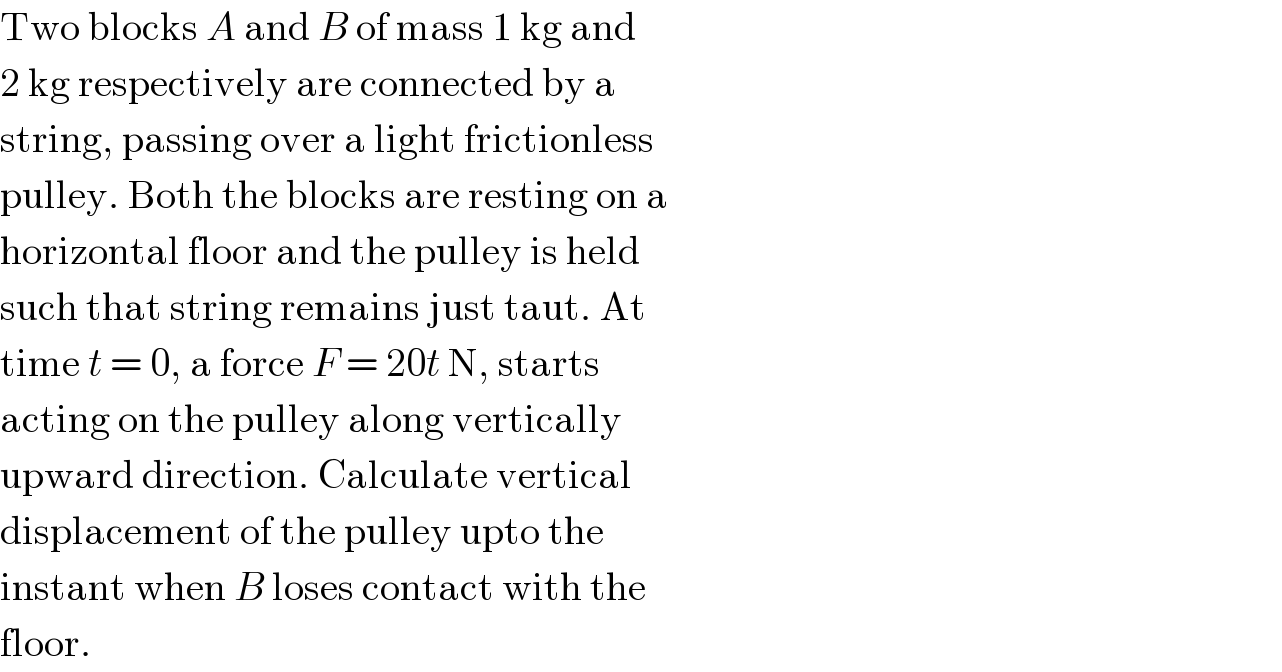
$$\mathrm{Two}\:\mathrm{blocks}\:{A}\:\mathrm{and}\:{B}\:\mathrm{of}\:\mathrm{mass}\:\mathrm{1}\:\mathrm{kg}\:\mathrm{and} \\ $$$$\mathrm{2}\:\mathrm{kg}\:\mathrm{respectively}\:\mathrm{are}\:\mathrm{connected}\:\mathrm{by}\:\mathrm{a} \\ $$$$\mathrm{string},\:\mathrm{passing}\:\mathrm{over}\:\mathrm{a}\:\mathrm{light}\:\mathrm{frictionless} \\ $$$$\mathrm{pulley}.\:\mathrm{Both}\:\mathrm{the}\:\mathrm{blocks}\:\mathrm{are}\:\mathrm{resting}\:\mathrm{on}\:\mathrm{a} \\ $$$$\mathrm{horizontal}\:\mathrm{floor}\:\mathrm{and}\:\mathrm{the}\:\mathrm{pulley}\:\mathrm{is}\:\mathrm{held} \\ $$$$\mathrm{such}\:\mathrm{that}\:\mathrm{string}\:\mathrm{remains}\:\mathrm{just}\:\mathrm{taut}.\:\mathrm{At} \\ $$$$\mathrm{time}\:{t}\:=\:\mathrm{0},\:\mathrm{a}\:\mathrm{force}\:{F}\:=\:\mathrm{20}{t}\:\mathrm{N},\:\mathrm{starts} \\ $$$$\mathrm{acting}\:\mathrm{on}\:\mathrm{the}\:\mathrm{pulley}\:\mathrm{along}\:\mathrm{vertically} \\ $$$$\mathrm{upward}\:\mathrm{direction}.\:\mathrm{Calculate}\:\mathrm{vertical} \\ $$$$\mathrm{displacement}\:\mathrm{of}\:\mathrm{the}\:\mathrm{pulley}\:\mathrm{upto}\:\mathrm{the} \\ $$$$\mathrm{instant}\:\mathrm{when}\:{B}\:\mathrm{loses}\:\mathrm{contact}\:\mathrm{with}\:\mathrm{the} \\ $$$$\mathrm{floor}. \\ $$
Commented by Tinkutara last updated on 04/Nov/17
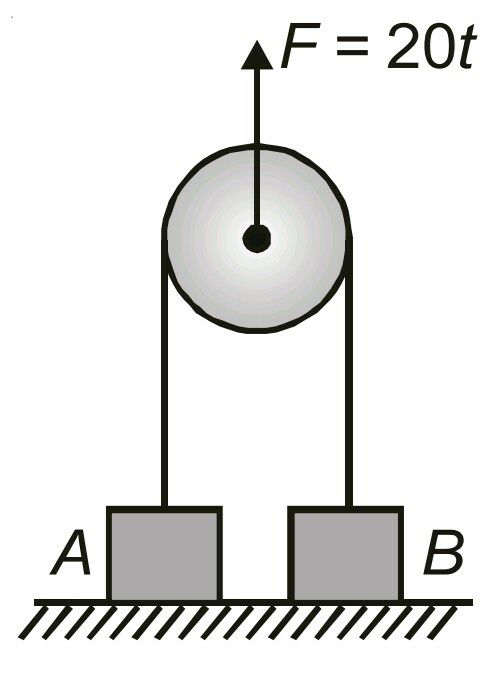
Commented by mrW1 last updated on 05/Nov/17
![I will try. Force in string is T. T=(F/2)=((20t)/2)=10t a_A =((T−m_A g)/m_A )=((10t−m_A g)/m_A )=((10t−10)/1)=10(t−1) a_B =((T−m_B g)/m_B )=((10t−m_B g)/m_B )=((10t−20)/2)=5(t−2) we see when t≥1 mass A is off ground and when t≥2 mass B is off ground. s_P =displacement of pulley v_P =velocity of pulley a_P =acceleration of pulley generally a_P =((a_A +a_B )/2) Phase (1): 0≤t≤1 both blocks are on ground, no motion. a_P =0, v_P =0, s_P =0. Phase (2): 1≤t≤2 block A is off ground with a_A =10(t−1). block B is still on ground a_B =0. a_P =((10(t−1))/2)=5(t−1) ⇒(dv_P /dt)=5(t−1) ∫_0 ^( v_P ) dv_P =5∫_1 ^t (t−1)dt v_P =(5/2)×[(t−1)^2 ]_1 ^t =((5(t−1)^2 )/2) ⇒(ds_P /dt)=((5(t−1)^2 )/2) ∫_0 ^( s_P ) ds_P =(5/2)∫_1 ^( t) (t−1)^2 dt s_P =(5/6)[(t−1)^3 ]_1 ^t =((5(t−1)^3 )/6) at t=2 v_P (2)=(5/2)(2−1)^2 =(5/2) m/s s_P (2)=(5/6)(2−1)^3 =(5/6) m i.e. as the block B takes off from ground the pulley has a displacement of (5/6) m. Phase (3): 2≤t both blocks are off ground. a_P =((10(t−1)+5(t−1))/2)=((15(t−1))/2) (dv_P /dt)=((15)/2)(t−1) ∫_(5/2) ^( v_P ) dv_P =((15)/2)∫_2 ^( t) (t−1)dt v_p −(5/2)=((15)/4)[(t−1)^2 −1] ⇒v_P =(5/4)[3(t−1)^2 −1] (ds_P /dt)=(5/4)[3(t−1)^2 −1] ∫_(6/5) ^s_P ds_P =(5/4)∫_2 ^( t) [3(t−1)^2 −1]dt s_P −(5/6)=(5/4)[(t−1)^3 −1]−(5/4)(t−2) s_P =(5/4)t(t−1)(t−2)+(5/6)](https://www.tinkutara.com/question/Q23729.png)
$$\mathrm{I}\:\mathrm{will}\:\mathrm{try}. \\ $$$$ \\ $$$$\mathrm{Force}\:\mathrm{in}\:\mathrm{string}\:\mathrm{is}\:\mathrm{T}. \\ $$$$\mathrm{T}=\frac{\mathrm{F}}{\mathrm{2}}=\frac{\mathrm{20t}}{\mathrm{2}}=\mathrm{10t} \\ $$$$\mathrm{a}_{\mathrm{A}} =\frac{\mathrm{T}−\mathrm{m}_{\mathrm{A}} \mathrm{g}}{\mathrm{m}_{\mathrm{A}} }=\frac{\mathrm{10t}−\mathrm{m}_{\mathrm{A}} \mathrm{g}}{\mathrm{m}_{\mathrm{A}} }=\frac{\mathrm{10t}−\mathrm{10}}{\mathrm{1}}=\mathrm{10}\left(\mathrm{t}−\mathrm{1}\right) \\ $$$$\mathrm{a}_{\mathrm{B}} =\frac{\mathrm{T}−\mathrm{m}_{\mathrm{B}} \mathrm{g}}{\mathrm{m}_{\mathrm{B}} }=\frac{\mathrm{10t}−\mathrm{m}_{\mathrm{B}} \mathrm{g}}{\mathrm{m}_{\mathrm{B}} }=\frac{\mathrm{10t}−\mathrm{20}}{\mathrm{2}}=\mathrm{5}\left(\mathrm{t}−\mathrm{2}\right) \\ $$$$\mathrm{we}\:\mathrm{see}\:\mathrm{when}\:\mathrm{t}\geqslant\mathrm{1}\:\mathrm{mass}\:\mathrm{A}\:\mathrm{is}\:\mathrm{off}\:\mathrm{ground} \\ $$$$\mathrm{and}\:\mathrm{when}\:\mathrm{t}\geqslant\mathrm{2}\:\mathrm{mass}\:\mathrm{B}\:\mathrm{is}\:\mathrm{off}\:\mathrm{ground}. \\ $$$$ \\ $$$$\mathrm{s}_{\mathrm{P}} =\mathrm{displacement}\:\mathrm{of}\:\mathrm{pulley} \\ $$$$\mathrm{v}_{\mathrm{P}} =\mathrm{velocity}\:\mathrm{of}\:\mathrm{pulley} \\ $$$$\mathrm{a}_{\mathrm{P}} =\mathrm{acceleration}\:\mathrm{of}\:\mathrm{pulley} \\ $$$$\mathrm{generally}\:\mathrm{a}_{\mathrm{P}} =\frac{\mathrm{a}_{\mathrm{A}} +\mathrm{a}_{\mathrm{B}} }{\mathrm{2}} \\ $$$$ \\ $$$$\mathrm{Phase}\:\left(\mathrm{1}\right):\:\mathrm{0}\leqslant\mathrm{t}\leqslant\mathrm{1} \\ $$$$\mathrm{both}\:\mathrm{blocks}\:\mathrm{are}\:\mathrm{on}\:\mathrm{ground},\:\mathrm{no}\:\mathrm{motion}. \\ $$$$\mathrm{a}_{\mathrm{P}} =\mathrm{0},\:\mathrm{v}_{\mathrm{P}} =\mathrm{0},\:\mathrm{s}_{\mathrm{P}} =\mathrm{0}. \\ $$$$ \\ $$$$\mathrm{Phase}\:\left(\mathrm{2}\right):\:\mathrm{1}\leqslant\mathrm{t}\leqslant\mathrm{2} \\ $$$$\mathrm{block}\:\mathrm{A}\:\mathrm{is}\:\mathrm{off}\:\mathrm{ground}\:\mathrm{with}\:\mathrm{a}_{\mathrm{A}} =\mathrm{10}\left(\mathrm{t}−\mathrm{1}\right). \\ $$$$\mathrm{block}\:\mathrm{B}\:\mathrm{is}\:\mathrm{still}\:\mathrm{on}\:\mathrm{ground}\:\mathrm{a}_{\mathrm{B}} =\mathrm{0}. \\ $$$$\mathrm{a}_{\mathrm{P}} =\frac{\mathrm{10}\left(\mathrm{t}−\mathrm{1}\right)}{\mathrm{2}}=\mathrm{5}\left(\mathrm{t}−\mathrm{1}\right) \\ $$$$\Rightarrow\frac{\mathrm{dv}_{\mathrm{P}} }{\mathrm{dt}}=\mathrm{5}\left(\mathrm{t}−\mathrm{1}\right) \\ $$$$\int_{\mathrm{0}} ^{\:\mathrm{v}_{\mathrm{P}} } \mathrm{dv}_{\mathrm{P}} =\mathrm{5}\int_{\mathrm{1}} ^{\mathrm{t}} \left(\mathrm{t}−\mathrm{1}\right)\mathrm{dt} \\ $$$$\mathrm{v}_{\mathrm{P}} =\frac{\mathrm{5}}{\mathrm{2}}×\left[\left(\mathrm{t}−\mathrm{1}\right)^{\mathrm{2}} \right]_{\mathrm{1}} ^{\mathrm{t}} =\frac{\mathrm{5}\left(\mathrm{t}−\mathrm{1}\right)^{\mathrm{2}} }{\mathrm{2}} \\ $$$$\Rightarrow\frac{\mathrm{ds}_{\mathrm{P}} }{\mathrm{dt}}=\frac{\mathrm{5}\left(\mathrm{t}−\mathrm{1}\right)^{\mathrm{2}} }{\mathrm{2}} \\ $$$$\int_{\mathrm{0}} ^{\:\mathrm{s}_{\mathrm{P}} } \mathrm{ds}_{\mathrm{P}} =\frac{\mathrm{5}}{\mathrm{2}}\int_{\mathrm{1}} ^{\:\mathrm{t}} \left(\mathrm{t}−\mathrm{1}\right)^{\mathrm{2}} \mathrm{dt} \\ $$$$\mathrm{s}_{\mathrm{P}} =\frac{\mathrm{5}}{\mathrm{6}}\left[\left(\mathrm{t}−\mathrm{1}\right)^{\mathrm{3}} \right]_{\mathrm{1}} ^{\mathrm{t}} =\frac{\mathrm{5}\left(\mathrm{t}−\mathrm{1}\right)^{\mathrm{3}} }{\mathrm{6}} \\ $$$$ \\ $$$$\mathrm{at}\:\mathrm{t}=\mathrm{2} \\ $$$$\mathrm{v}_{\mathrm{P}} \left(\mathrm{2}\right)=\frac{\mathrm{5}}{\mathrm{2}}\left(\mathrm{2}−\mathrm{1}\right)^{\mathrm{2}} =\frac{\mathrm{5}}{\mathrm{2}}\:\mathrm{m}/\mathrm{s} \\ $$$$\mathrm{s}_{\mathrm{P}} \left(\mathrm{2}\right)=\frac{\mathrm{5}}{\mathrm{6}}\left(\mathrm{2}−\mathrm{1}\right)^{\mathrm{3}} =\frac{\mathrm{5}}{\mathrm{6}}\:\mathrm{m} \\ $$$$\mathrm{i}.\mathrm{e}.\:\mathrm{as}\:\mathrm{the}\:\mathrm{block}\:\mathrm{B}\:\mathrm{takes}\:\mathrm{off}\:\mathrm{from}\:\mathrm{ground} \\ $$$$\mathrm{the}\:\mathrm{pulley}\:\mathrm{has}\:\mathrm{a}\:\mathrm{displacement}\:\mathrm{of}\:\frac{\mathrm{5}}{\mathrm{6}}\:\mathrm{m}. \\ $$$$ \\ $$$$\mathrm{Phase}\:\left(\mathrm{3}\right):\:\mathrm{2}\leqslant\mathrm{t} \\ $$$$\mathrm{both}\:\mathrm{blocks}\:\mathrm{are}\:\mathrm{off}\:\mathrm{ground}. \\ $$$$\mathrm{a}_{\mathrm{P}} =\frac{\mathrm{10}\left(\mathrm{t}−\mathrm{1}\right)+\mathrm{5}\left(\mathrm{t}−\mathrm{1}\right)}{\mathrm{2}}=\frac{\mathrm{15}\left(\mathrm{t}−\mathrm{1}\right)}{\mathrm{2}} \\ $$$$\frac{\mathrm{dv}_{\mathrm{P}} }{\mathrm{dt}}=\frac{\mathrm{15}}{\mathrm{2}}\left(\mathrm{t}−\mathrm{1}\right) \\ $$$$\int_{\frac{\mathrm{5}}{\mathrm{2}}} ^{\:\mathrm{v}_{\mathrm{P}} } \mathrm{dv}_{\mathrm{P}} =\frac{\mathrm{15}}{\mathrm{2}}\int_{\mathrm{2}} ^{\:\mathrm{t}} \left(\mathrm{t}−\mathrm{1}\right)\mathrm{dt} \\ $$$$\mathrm{v}_{\mathrm{p}} −\frac{\mathrm{5}}{\mathrm{2}}=\frac{\mathrm{15}}{\mathrm{4}}\left[\left(\mathrm{t}−\mathrm{1}\right)^{\mathrm{2}} −\mathrm{1}\right] \\ $$$$\Rightarrow\mathrm{v}_{\mathrm{P}} =\frac{\mathrm{5}}{\mathrm{4}}\left[\mathrm{3}\left(\mathrm{t}−\mathrm{1}\right)^{\mathrm{2}} −\mathrm{1}\right] \\ $$$$\frac{\mathrm{ds}_{\mathrm{P}} }{\mathrm{dt}}=\frac{\mathrm{5}}{\mathrm{4}}\left[\mathrm{3}\left(\mathrm{t}−\mathrm{1}\right)^{\mathrm{2}} −\mathrm{1}\right] \\ $$$$\int_{\frac{\mathrm{6}}{\mathrm{5}}} ^{\mathrm{s}_{\mathrm{P}} } \mathrm{ds}_{\mathrm{P}} =\frac{\mathrm{5}}{\mathrm{4}}\int_{\mathrm{2}} ^{\:\mathrm{t}} \left[\mathrm{3}\left(\mathrm{t}−\mathrm{1}\right)^{\mathrm{2}} −\mathrm{1}\right]\mathrm{dt} \\ $$$$\mathrm{s}_{\mathrm{P}} −\frac{\mathrm{5}}{\mathrm{6}}=\frac{\mathrm{5}}{\mathrm{4}}\left[\left(\mathrm{t}−\mathrm{1}\right)^{\mathrm{3}} −\mathrm{1}\right]−\frac{\mathrm{5}}{\mathrm{4}}\left(\mathrm{t}−\mathrm{2}\right) \\ $$$$\mathrm{s}_{\mathrm{P}} =\frac{\mathrm{5}}{\mathrm{4}}\mathrm{t}\left(\mathrm{t}−\mathrm{1}\right)\left(\mathrm{t}−\mathrm{2}\right)+\frac{\mathrm{5}}{\mathrm{6}} \\ $$
Commented by mrW1 last updated on 05/Nov/17
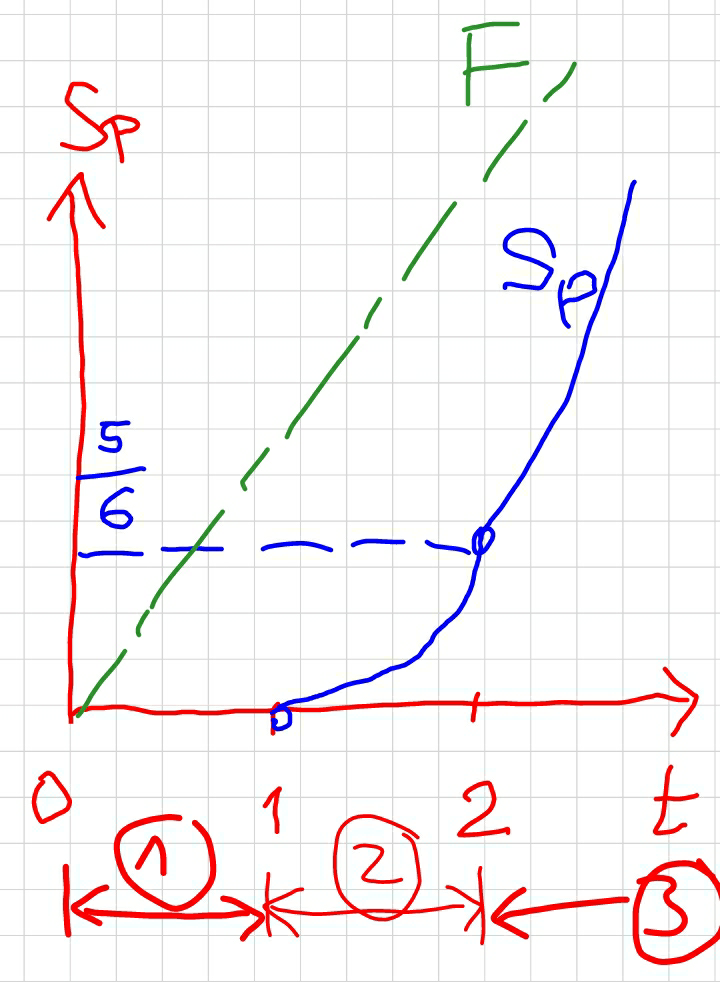
Commented by Tinkutara last updated on 09/Nov/17

$$\mathrm{Thank}\:\mathrm{you}\:\mathrm{very}\:\mathrm{much}\:\mathrm{Sir}! \\ $$
Answered by ajfour last updated on 04/Nov/17
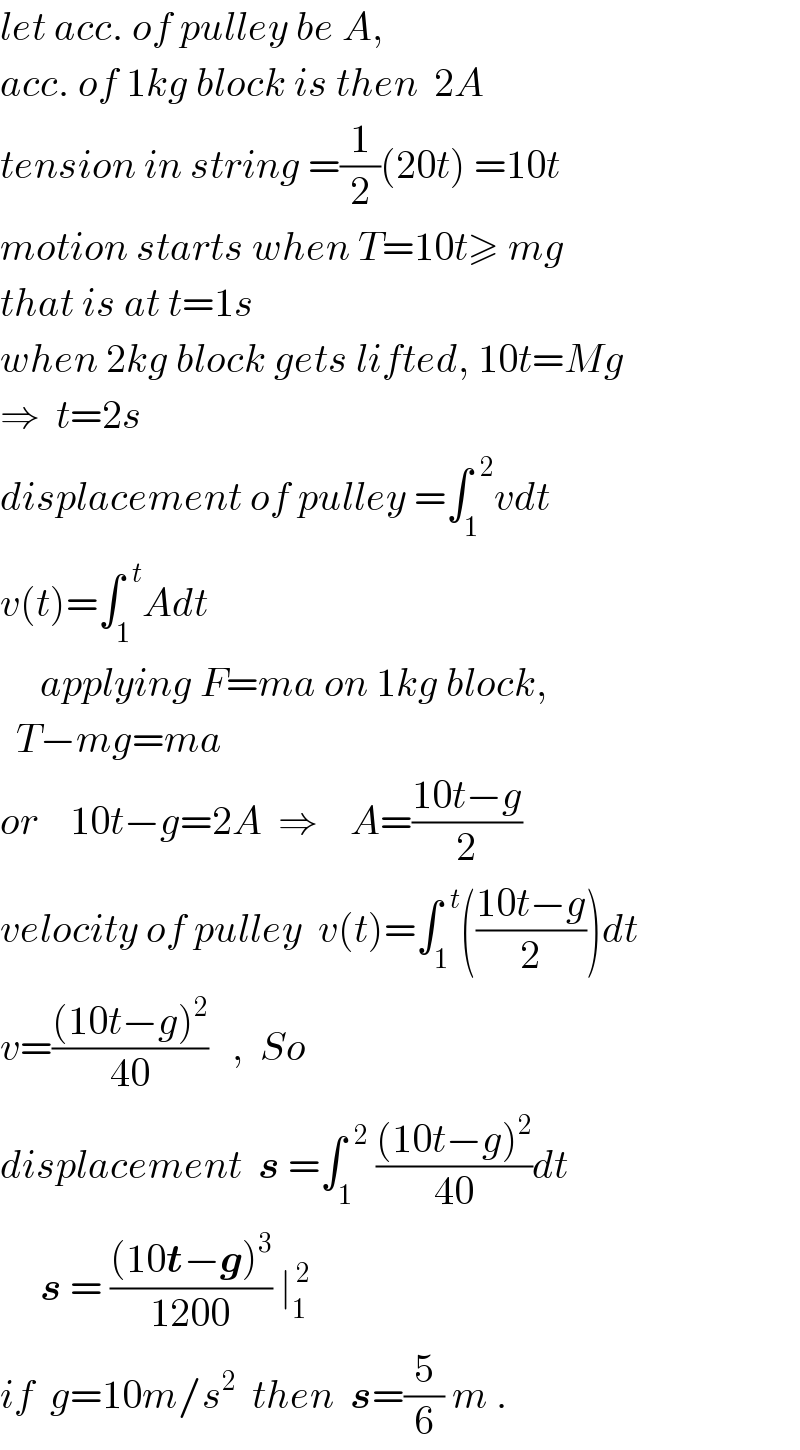
$${let}\:{acc}.\:{of}\:{pulley}\:{be}\:{A}, \\ $$$${acc}.\:{of}\:\mathrm{1}{kg}\:{block}\:{is}\:{then}\:\:\mathrm{2}{A} \\ $$$${tension}\:{in}\:{string}\:=\frac{\mathrm{1}}{\mathrm{2}}\left(\mathrm{20}{t}\right)\:=\mathrm{10}{t} \\ $$$${motion}\:{starts}\:{when}\:{T}=\mathrm{10}{t}\geqslant\:{mg} \\ $$$${that}\:{is}\:{at}\:{t}=\mathrm{1}{s} \\ $$$${when}\:\mathrm{2}{kg}\:{block}\:{gets}\:{lifted},\:\mathrm{10}{t}={Mg} \\ $$$$\Rightarrow\:\:{t}=\mathrm{2}{s} \\ $$$${displacement}\:{of}\:{pulley}\:=\int_{\mathrm{1}} ^{\:\:\mathrm{2}} {vdt} \\ $$$${v}\left({t}\right)=\int_{\mathrm{1}} ^{\:\:{t}} {Adt} \\ $$$$\:\:\:\:\:{applying}\:{F}={ma}\:{on}\:\mathrm{1}{kg}\:{block}, \\ $$$$\:\:{T}−{mg}={ma} \\ $$$${or}\:\:\:\:\mathrm{10}{t}−{g}=\mathrm{2}{A}\:\:\Rightarrow\:\:\:\:{A}=\frac{\mathrm{10}{t}−{g}}{\mathrm{2}} \\ $$$${velocity}\:{of}\:{pulley}\:\:{v}\left({t}\right)=\int_{\mathrm{1}} ^{\:\:{t}} \left(\frac{\mathrm{10}{t}−{g}}{\mathrm{2}}\right){dt} \\ $$$${v}=\frac{\left(\mathrm{10}{t}−{g}\right)^{\mathrm{2}} }{\mathrm{40}}\:\:\:,\:\:{So}\:\:\: \\ $$$${displacement}\:\:\boldsymbol{{s}}\:=\int_{\mathrm{1}} ^{\:\:\mathrm{2}} \:\frac{\left(\mathrm{10}{t}−{g}\right)^{\mathrm{2}} }{\mathrm{40}}{dt} \\ $$$$\:\:\:\:\:\boldsymbol{{s}}\:=\:\frac{\left(\mathrm{10}\boldsymbol{{t}}−\boldsymbol{{g}}\right)^{\mathrm{3}} }{\mathrm{1200}}\:\mid_{\mathrm{1}} ^{\:\mathrm{2}} \:\: \\ $$$${if}\:\:{g}=\mathrm{10}{m}/{s}^{\mathrm{2}} \:\:{then}\:\:\boldsymbol{{s}}=\frac{\mathrm{5}}{\mathrm{6}}\:{m}\:. \\ $$
Commented by Tinkutara last updated on 04/Nov/17

$${Why}\:{displacement}\:{is}\:{not}\:\underset{\mathrm{0}} {\overset{\mathrm{2}} {\int}}{vdt}?\:{And} \\ $$$${why}\:{we}\:{take}\:{v}\left({t}\right)\:{of}\:{block}\:{A}\:{only}? \\ $$
Commented by ajfour last updated on 04/Nov/17
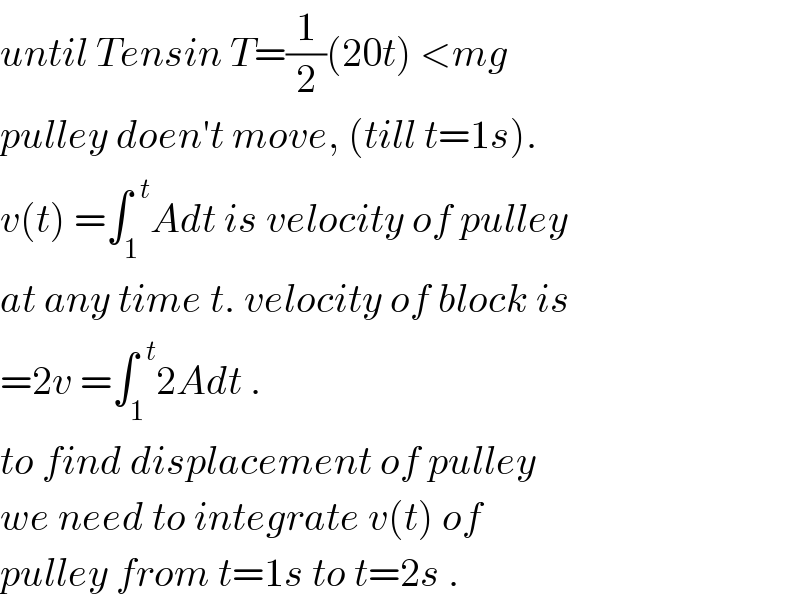
$${until}\:{Tensin}\:{T}=\frac{\mathrm{1}}{\mathrm{2}}\left(\mathrm{20}{t}\right)\:<{mg}\: \\ $$$${pulley}\:{doen}'{t}\:{move},\:\left({till}\:{t}=\mathrm{1}{s}\right). \\ $$$${v}\left({t}\right)\:=\int_{\mathrm{1}} ^{\:\:{t}} {Adt}\:{is}\:{velocity}\:{of}\:{pulley} \\ $$$${at}\:{any}\:{time}\:{t}.\:{velocity}\:{of}\:{block}\:{is} \\ $$$$=\mathrm{2}{v}\:=\int_{\mathrm{1}} ^{\:\:{t}} \mathrm{2}{Adt}\:. \\ $$$${to}\:{find}\:{displacement}\:{of}\:{pulley} \\ $$$${we}\:{need}\:{to}\:{integrate}\:{v}\left({t}\right)\:{of} \\ $$$${pulley}\:{from}\:{t}=\mathrm{1}{s}\:{to}\:{t}=\mathrm{2}{s}\:. \\ $$
Commented by mrW1 last updated on 09/Nov/17
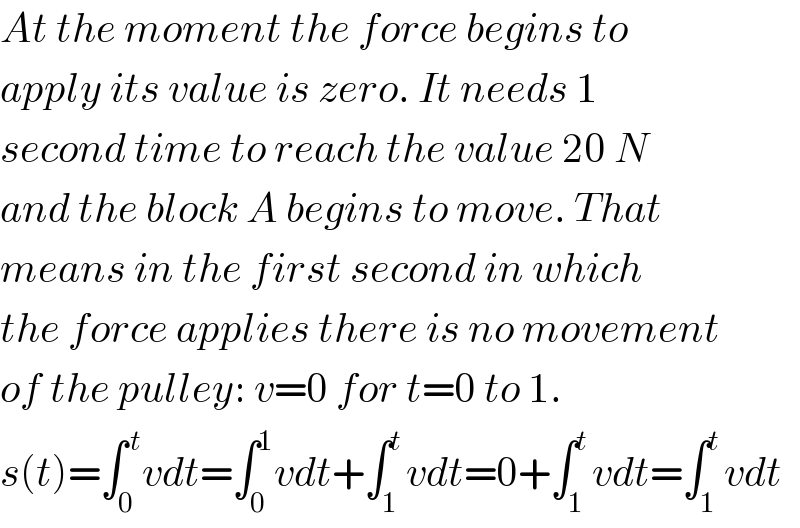
$${At}\:{the}\:{moment}\:{the}\:{force}\:{begins}\:{to} \\ $$$${apply}\:{its}\:{value}\:{is}\:{zero}.\:{It}\:{needs}\:\mathrm{1}\: \\ $$$${second}\:{time}\:{to}\:{reach}\:{the}\:{value}\:\mathrm{20}\:{N} \\ $$$${and}\:{the}\:{block}\:{A}\:{begins}\:{to}\:{move}.\:{That} \\ $$$${means}\:{in}\:{the}\:{first}\:{second}\:{in}\:{which} \\ $$$${the}\:{force}\:{applies}\:{there}\:{is}\:{no}\:{movement} \\ $$$${of}\:{the}\:{pulley}:\:{v}=\mathrm{0}\:{for}\:{t}=\mathrm{0}\:{to}\:\mathrm{1}. \\ $$$${s}\left({t}\right)=\int_{\mathrm{0}} ^{\:{t}} {vdt}=\int_{\mathrm{0}} ^{\mathrm{1}} {vdt}+\int_{\mathrm{1}} ^{{t}} {vdt}=\mathrm{0}+\int_{\mathrm{1}} ^{{t}} {vdt}=\int_{\mathrm{1}} ^{{t}} {vdt} \\ $$
Commented by Tinkutara last updated on 09/Nov/17

$$\mathrm{Thank}\:\mathrm{you}\:\mathrm{very}\:\mathrm{much}\:\mathrm{Sir}! \\ $$$$\mathrm{The}\:\mathrm{pulley}\:\mathrm{moves}\:\mathrm{only}\:\mathrm{when}\:\mathrm{either}\:\mathrm{of} \\ $$$$\mathrm{the}\:\mathrm{two}\:\mathrm{blocks}\:\mathrm{lifts}\:\mathrm{up}?\:\mathrm{Why}\:\mathrm{not}\:\mathrm{from} \\ $$$$\mathrm{the}\:\mathrm{moment}\:\mathrm{when}\:\mathrm{force}\:\mathrm{is}\:\mathrm{applied}\:\mathrm{on}\:\mathrm{it}? \\ $$
Commented by Tinkutara last updated on 09/Nov/17

$${Before}\:\mathrm{1}\:{second},\:{say}\:\mathrm{0}.\mathrm{5}\:{second},\:{force} \\ $$$${applied}\:{is}\:\mathrm{10}\:{N}\:{on}\:{the}\:{pulley}\:{and}\:{it}\:{is} \\ $$$${continuously}\:{increasing}.\:{So}\:{why} \\ $$$${pulley}\:{does}\:{not}\:{move}\:{with}\:{this}\:{force}? \\ $$
Commented by mrW1 last updated on 09/Nov/17
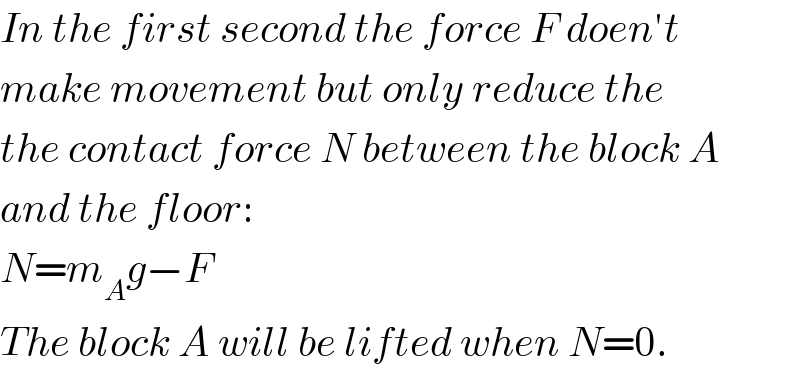
$${In}\:{the}\:{first}\:{second}\:{the}\:{force}\:{F}\:{doen}'{t} \\ $$$${make}\:{movement}\:{but}\:{only}\:{reduce}\:{the} \\ $$$${the}\:{contact}\:{force}\:{N}\:{between}\:{the}\:{block}\:{A} \\ $$$${and}\:{the}\:{floor}: \\ $$$${N}={m}_{{A}} {g}−{F} \\ $$$${The}\:{block}\:{A}\:{will}\:{be}\:{lifted}\:{when}\:{N}=\mathrm{0}. \\ $$
Commented by Tinkutara last updated on 09/Nov/17

$$\mathrm{OK}.\:\mathrm{But}\:\mathrm{when}\:\mathrm{block}\:\mathrm{1}\:\mathrm{is}\:\mathrm{lifted}\:\mathrm{at}\:\mathrm{1}\:\mathrm{s} \\ $$$$\mathrm{block}\:\mathrm{2}\:\mathrm{is}\:\mathrm{not}\:\mathrm{lifted}.\:\mathrm{So}\:\mathrm{why}\:\mathrm{the}\:\mathrm{pulley} \\ $$$$\mathrm{still}\:\mathrm{moves}\:\mathrm{without}\:\mathrm{lifting}\:\mathrm{of}\:\mathrm{block}\:\mathrm{2}? \\ $$
Commented by mrW1 last updated on 09/Nov/17

$${Since}\:{F}\:{must}\:{be}\:\mathrm{40}\:{N}\:{to}\:{lift}\:{the}\:{block} \\ $$$${B}.\:{So}\:{in}\:{the}\:{time}\:{t}=\mathrm{1}\:{to}\:\mathrm{2}\:{only}\:{block} \\ $$$${A}\:{moves}.\:{When}\:{block}\:{A}\:{moves},\:{the} \\ $$$${pulley}\:{moves}\:{also}. \\ $$
Commented by Tinkutara last updated on 09/Nov/17

$$\mathrm{Thank}\:\mathrm{you}\:\mathrm{very}\:\mathrm{much}\:\mathrm{Sir}! \\ $$$$\mathrm{All}\:\mathrm{doubts}\:\mathrm{cleared}. \\ $$
